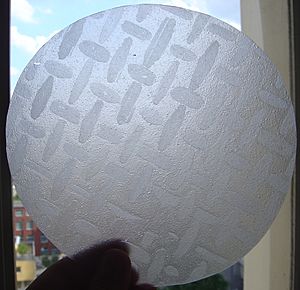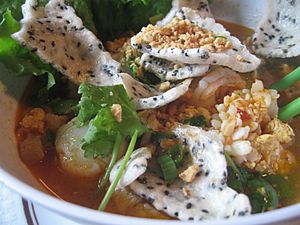Bánh tráng facts for kids

A bánh tráng wrapper
|
|
| Type | Edible wrapper |
|---|---|
| Place of origin | Vietnam |
| Region or state | Southeast Asia |
| Main ingredients | Rice flour or tapioca starch (or both), and various ingredients, including spices |
| Variations | Thin, soft to thick, depending on the type of banh trang |
Bánh tráng (pronounced "banh trang") is a Vietnamese term for a special kind of edible wrapper. You might also hear it called rice paper wrappers, rice crepes, or nem wrappers. These wrappers are a key part of Vietnamese cuisine, especially for finger foods and appetizers like Vietnamese spring rolls. Even though they are often called "rice paper," some bánh tráng are made mostly from tapioca flour, or a mix of rice and tapioca flour. A popular roasted version is called bánh tráng nướng.
Contents
- What is Bánh tráng?
- Different Kinds of Bánh tráng
- Common Bánh tráng
- Bánh đa nướng / Bánh tráng nướng (Grilled Rice Cracker)
- Bánh đa nem (Northern Rice Paper)
- Bánh tráng rế (Woven Bánh tráng)
- Bánh tráng mè (Sesame Bánh tráng)
- Bánh tráng tôm mè (Sesame-Shrimp Bánh tráng)
- Bánh tráng sữa (Milky Bánh tráng)
- Bánh tráng dẻo (Soft Bánh tráng)
- Bánh tráng mỏng (Thin Bánh tráng)
- Bánh tráng chuối (Banana Flavored Bánh tráng)
- Bánh tráng dừa (Coconut Flavored Bánh tráng)
- Bánh tráng phơi sương (Dew-Wetted Bánh tráng)
- Bánh tráng trộn (Mixed Rice Paper Salad)
- How Bánh tráng is Used in Cooking
- Bánh tráng Around the World
What is Bánh tráng?

Vietnamese bánh tráng are thin, edible wrappers. They are traditionally made by steaming a batter of rice flour, then drying it in the sun. Today, machines are often used to steam and dry the wrappers. This makes them thinner and cleaner, which is great for selling them to other countries.
Different Kinds of Bánh tráng
Bánh tráng wrappers come in many different textures, shapes, and types. Some are very thin and soft, while others are thick, like a crunchy rice cracker. They are usually round or square. Many local Vietnamese ingredients and spices are added to bánh tráng to create different tastes and textures. These can include sesame seeds, chili, coconut milk, bananas, and durian.
Common Bánh tráng
This is the most common type of rice wrapper, especially in Southern Vietnam and other countries. These wrappers are made from a mix of rice flour, tapioca starch, water, and salt. They are thin and light. You'll often find them used for chả giò (fried spring rolls) and gỏi cuốn (fresh spring rolls). Some types are made especially for frying.
Bánh đa nướng / Bánh tráng nướng (Grilled Rice Cracker)
These are rice crackers that have been roasted or grilled. They can be thicker than regular rice wrappers and often have sesame seeds. Bánh đa nướng is often used as a crunchy topping for dishes like Mì Quảng. Don't confuse it with the street food from Đà Lạt that is sometimes called "Vietnamese pizza."
Bánh đa nem (Northern Rice Paper)
This is the term for rice paper used in Northern Vietnam. A special kind is made only from rice flour, water, and salt, with no tapioca starch. Some brown bánh đa nem might even contain cane syrup. These wrappers are very thin and see-through. They don't need to be soaked in water before you use them. When fried, they become very crispy, not chewy like the Southern types. They are often used for making nem cua bể (crab spring rolls).
Bánh tráng rế (Woven Bánh tráng)
These wrappers are made from rice flour, green beans, vegetable oil, and salt. They are very delicate and thin. They look like a lacy, net-like pattern. They are typically used for deep-fried chả giò rolls, making them look extra special.
Bánh tráng mè (Sesame Bánh tráng)
These wrappers are usually made from rice starch with sesame seeds added. Their texture is similar to a rice cracker.
Bánh tráng tôm mè (Sesame-Shrimp Bánh tráng)
These wrappers are made by adding sesame seeds and dried shrimps. Like the sesame version, their texture is similar to a rice cracker.
Bánh tráng sữa (Milky Bánh tráng)
Bánh tráng sữa are made by adding milk. This type of bánh tráng is softer and is meant to melt in your mouth.
Bánh tráng dẻo (Soft Bánh tráng)
Bánh tráng dẻo are soft and bendy sheets. They can also come in different flavors.
Bánh tráng mỏng (Thin Bánh tráng)
These are very thin sheets made only from tapioca starch. They are dried and see-through. When you add water, they become quite sticky.
Bánh tráng chuối (Banana Flavored Bánh tráng)
These wrappers are typically made by adding bananas. Their texture is similar to a rice cracker.
Bánh tráng dừa (Coconut Flavored Bánh tráng)
These wrappers are usually made with coconut milk, sugar, rice flour, sesame seeds, and water. Their texture is like a cracker, similar to the sesame bánh tráng.
Bánh tráng phơi sương (Dew-Wetted Bánh tráng)
Bánh tráng phơi sương are special wrappers that have two flexible layers of rice paper.
Bánh tráng trộn (Mixed Rice Paper Salad)
Mixed rice paper is a popular snack where the main ingredient is rice paper cut into strips. It's then mixed with fried dried shrimp and other tasty ingredients.
How Bánh tráng is Used in Cooking

Bánh tráng wrappers are often used in Vietnamese nem dishes. You can eat these wrappers dried, fried, baked, or soaked in water. They are commonly served rolled up, baked, or added to salads, soups, and stir-fried Vietnamese dishes.
The light, clear traditional bánh tráng wrappers are perfect for many Vietnamese rolls, especially gỏi cuốn (fresh salad rolls). While often used for fresh rolls, Northern Vietnamese cuisine also uses these wrappers for chả giò (Northern Vietnamese: Nem rán), which are crispy, fried spring rolls. Traditional bánh tráng wrappers are also used to wrap common Vietnamese dishes like bánh xèo (Vietnamese sizzling pancakes), bò 7 món (Vietnamese seven courses of beef), and cá nướng (Vietnamese grilled fish). You then dip them into a sauce.
Traditional bánh tráng wrappers are also used to make a Vietnamese salad dish called bánh tráng trộn (mixed bánh tráng salad).
Woven bánh tráng wrappers are usually deep-fried to make beautiful and crispy chả giò (Vietnamese crispy spring rolls).
Sesame bánh tráng wrappers are often baked or soaked in water, depending on how you like them. They are then served with salads, Mì Quảng, and various other dishes.
Bánh tráng Around the World
You can find bánh tráng wrappers in many countries outside Vietnam. This is thanks to the Vietnamese diaspora, which means Vietnamese people living in different parts of the world.

